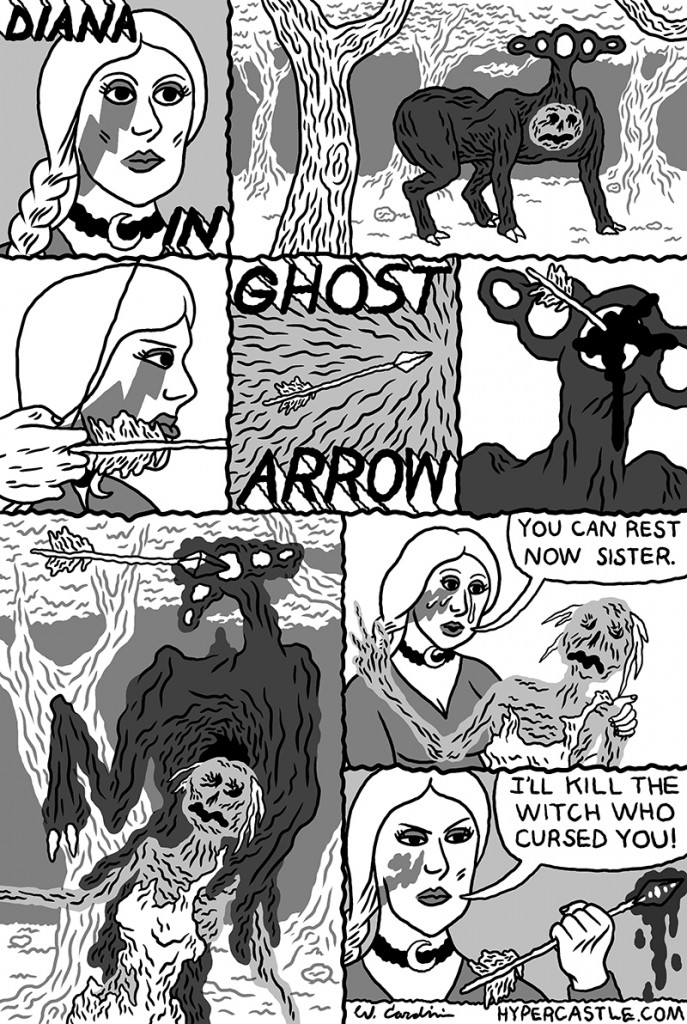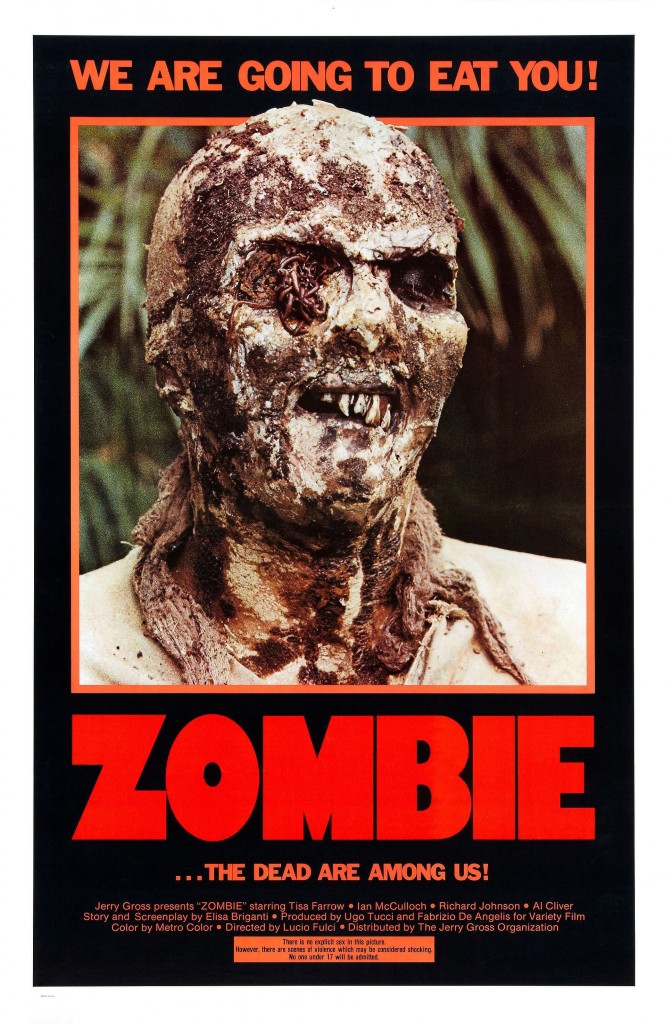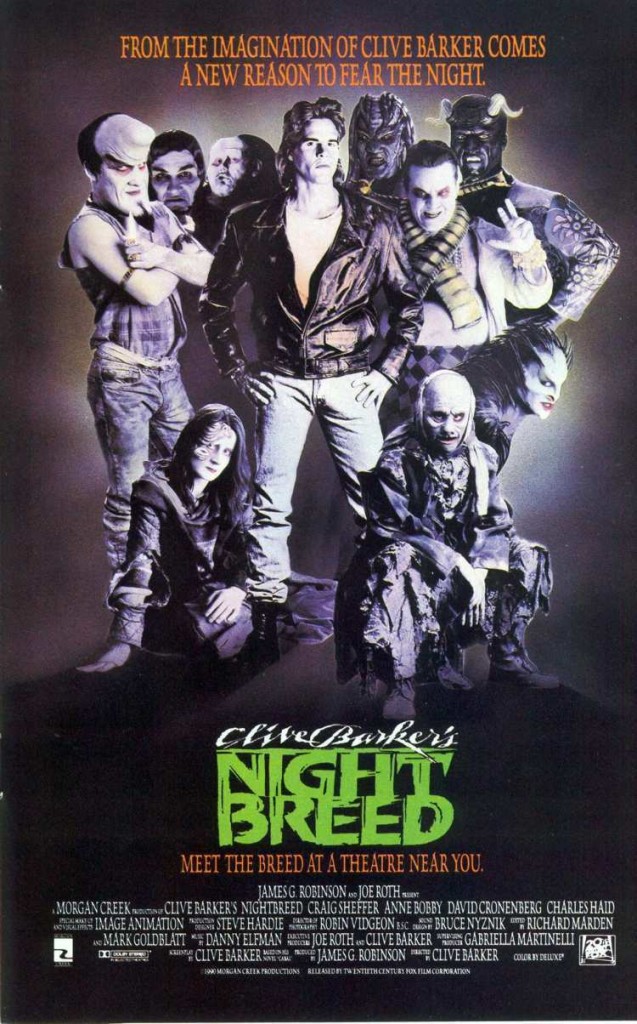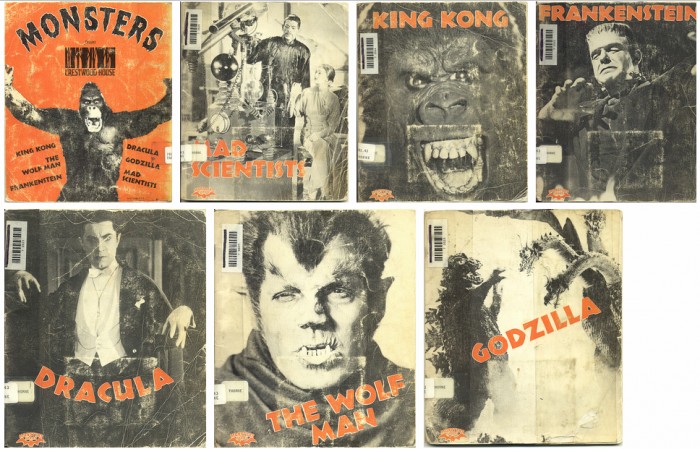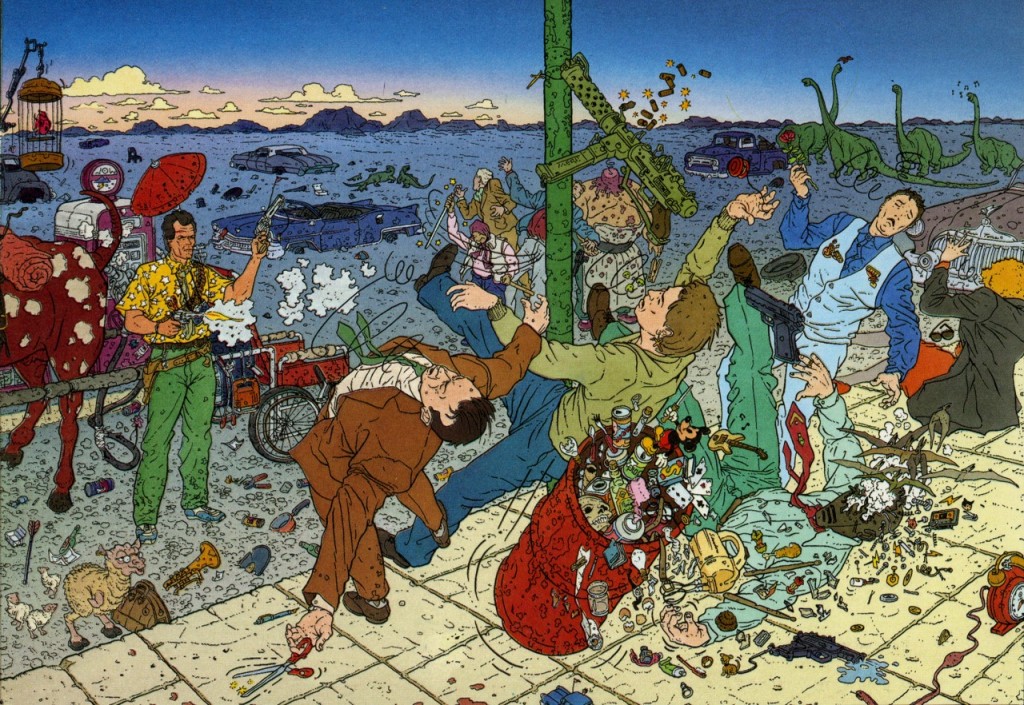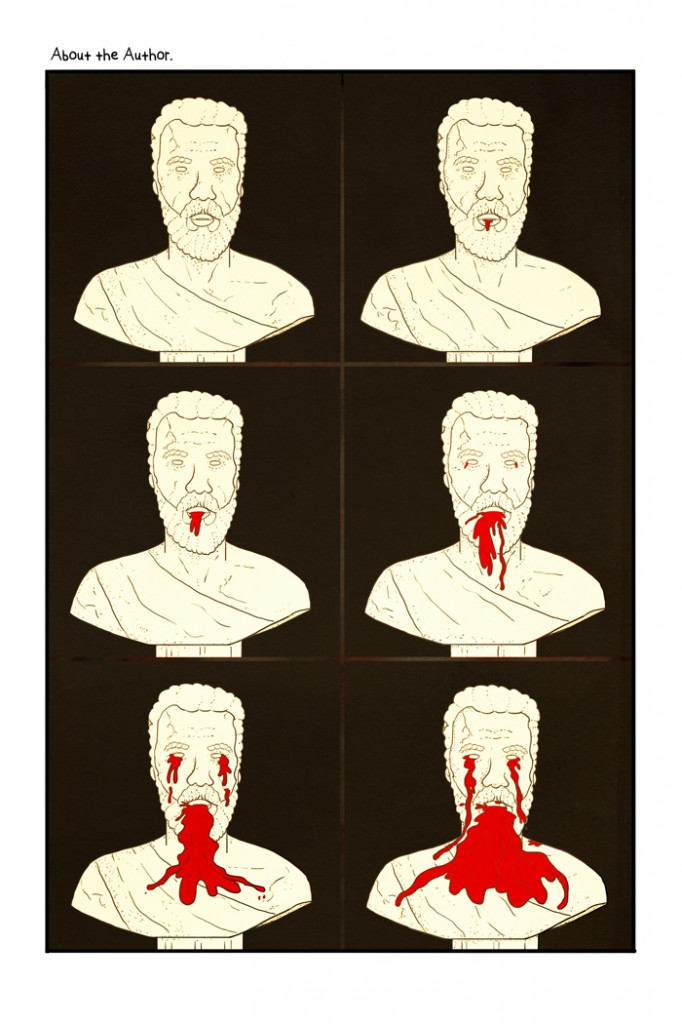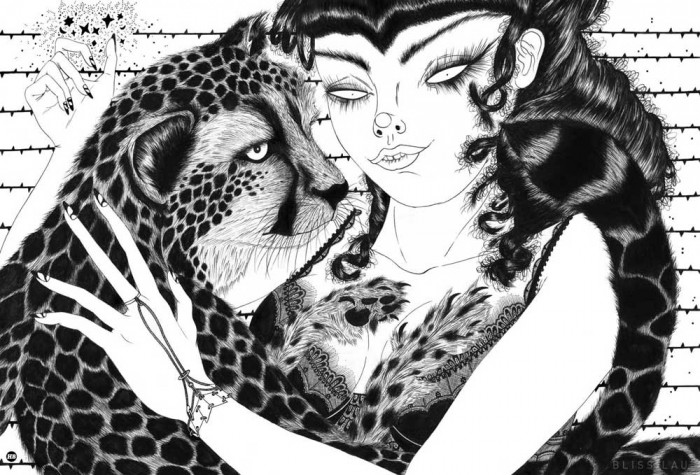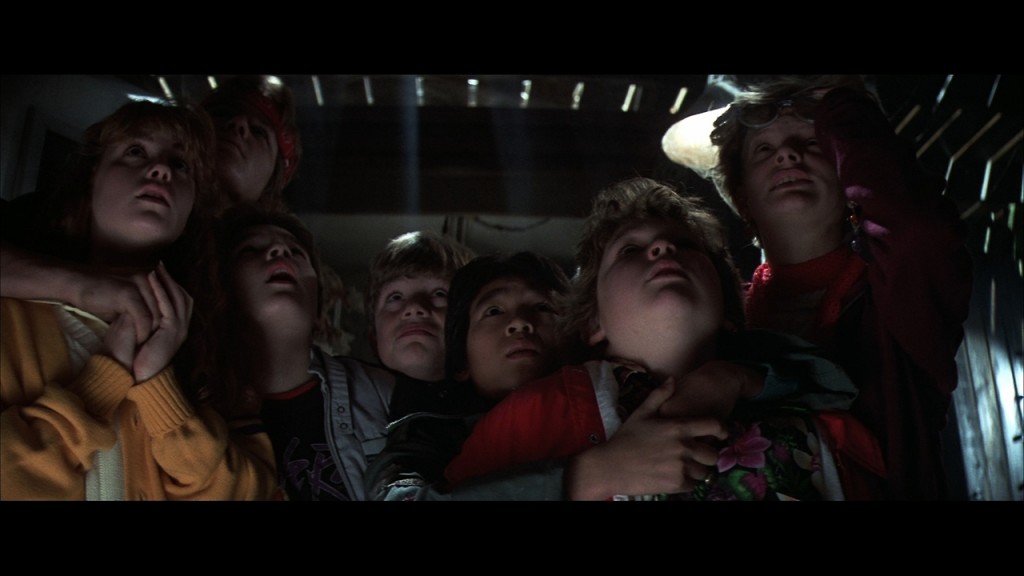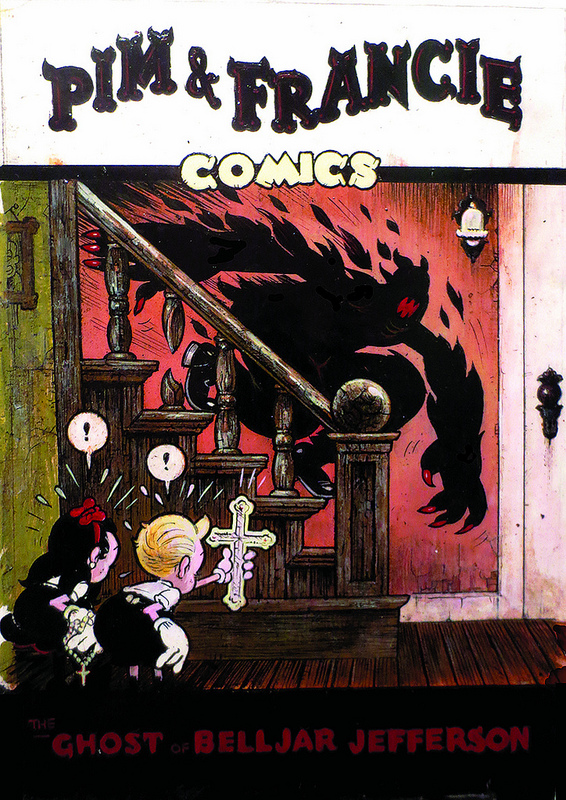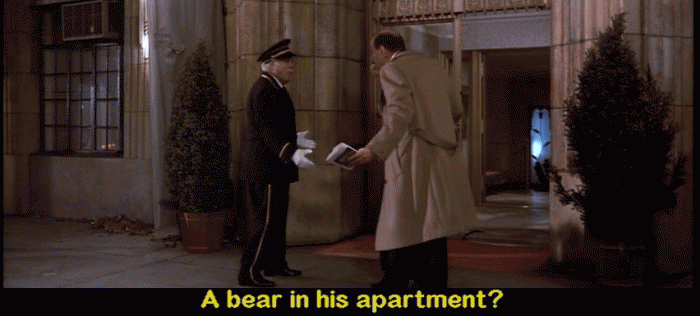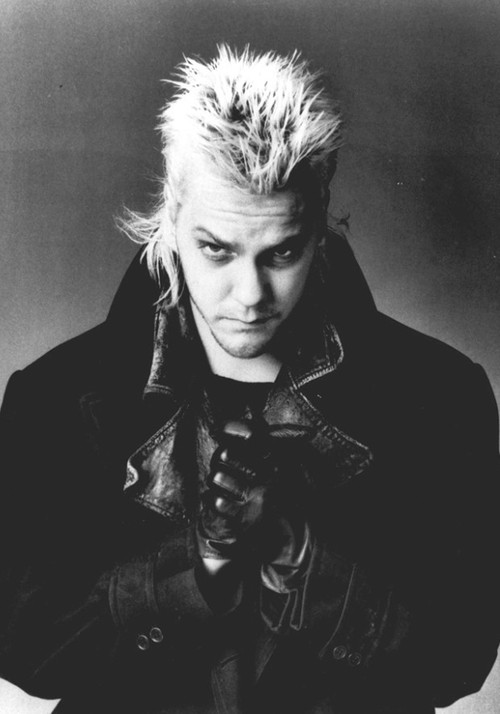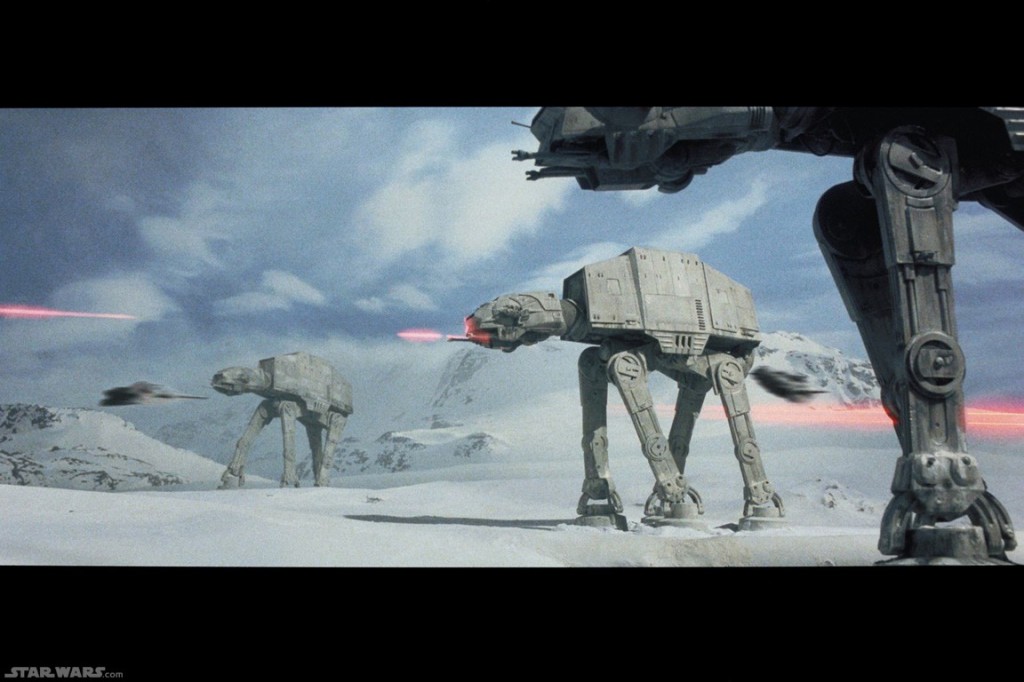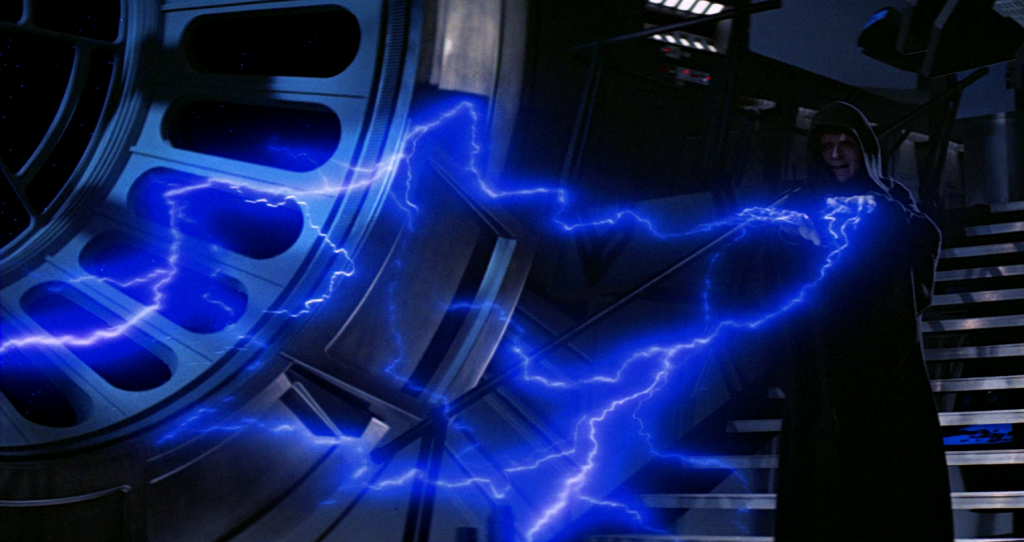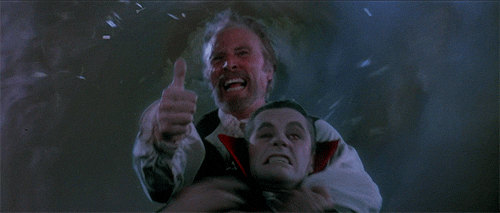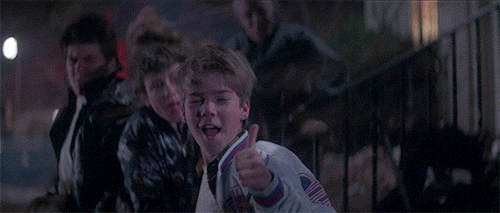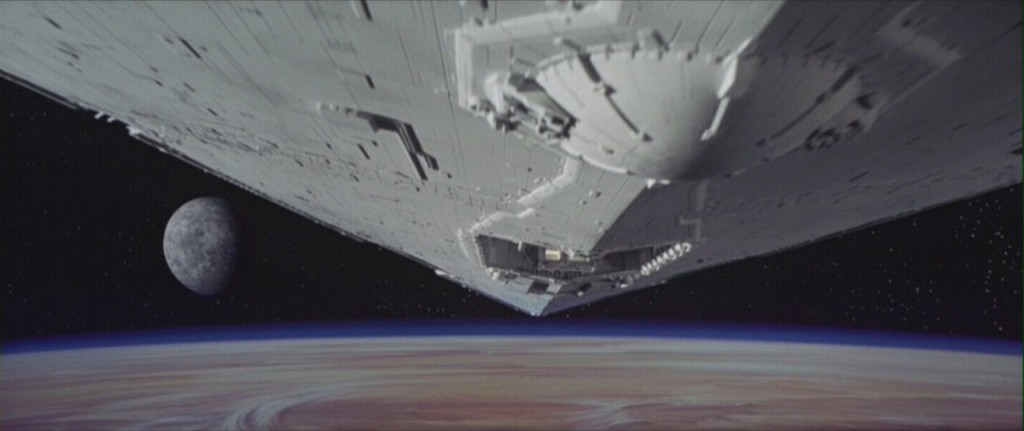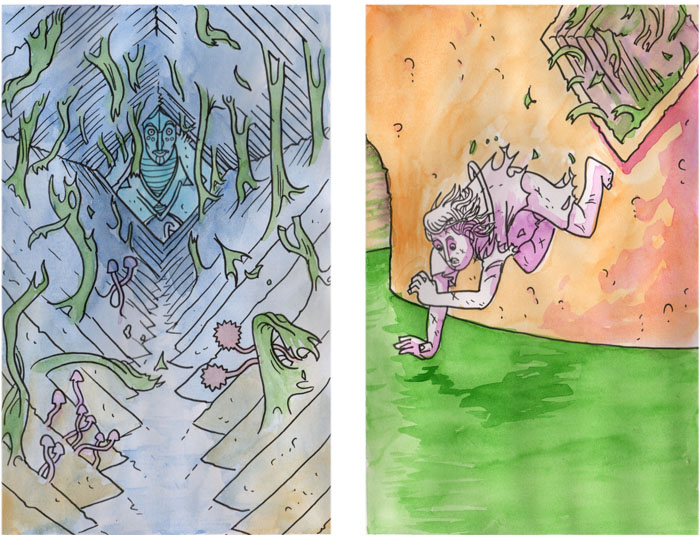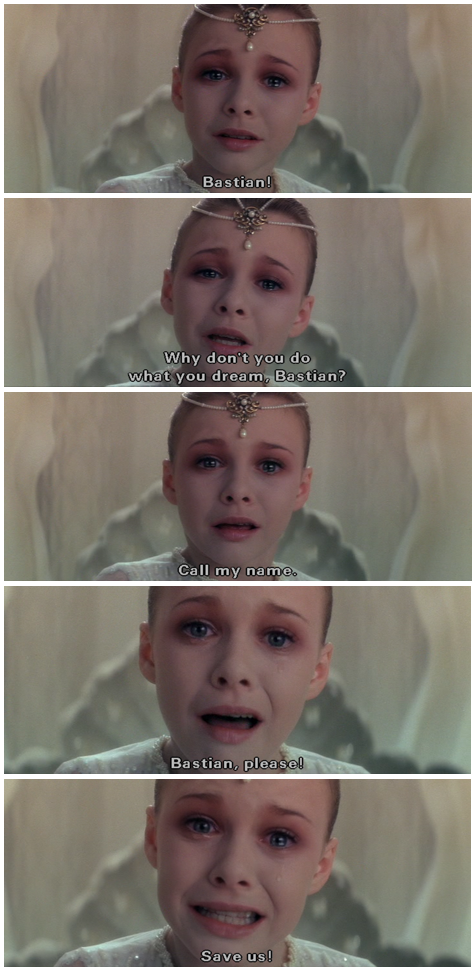Posts Tagged ‘movie reviews’
Movie Time: The Hobbit: The Desolation of Smaug and The Wolf of Wall Street
December 27, 2013There’s an invented scene in Peter Jackson’s second Hobbit movie (SPOILER ALERT, I GUESS) where Thorin & Company fire up the forges of the Lonely Mountain while dodging an awoken and enraged Smaug the Golden. River-like torrents of molten gold pour into a mold of (presumably) Durin, the ur-Dwarf, that’s about the size of a medium-sized office building. Smaug stares at it enraptured until the heat causes it to break form and gush golden death all over the dragon. Wealth, weaponized. Find all the metaphors for a three-film Hobbit adaptation you like in that scene, go ahead, knock yourself out. Certainly this film’s herky-jerky rhythm, and its need to surround every emotional turning point with an invented ten-minute action sequence, will give you plenty of fuel for the fire. But ultimately Smaug rises again from that lake of fire, bellows a mockery of the Dwarves’ attempt at revenge, flies up into the night sky gilded with real actual gold, shakes it off into a million droplets like a sheepdog drying off after a bath, and flies off toward Laketown to burn it to ashes while shrieking “I AM DEATH.” If I get to see something like that at the movies, Peter Jackson can melt down all the rivers of gold he wants.
Wolf was more fun than Good, and I say that as someone whose favorite Martin Scorsese movie is Casino. One of the reasons it feels a bit light in the end is that we never meet any victims of the penny-stock scams at the heart of the thing, just the scammers and their trials and tribulations. In a sense, that’s Scorsese’s approach with GoodFellas and Casino as well, but in those films the characters frequently turn on and kill each other, so you’re made to understand that the criminality has real-life consequences even if only on other criminals. You see victims; they just happen to be the victimizers as well. This, on the other hand, is just DiCaprio and Jonah Hill being really funny for three hours, with tons of naked women and quaaludes. Which I liked, don’t get me wrong, but it’s almost like Scorsese and Terence Winter (Boardwalk Empire impresario, hence a couple of notable BE castmember cameos) went out of their way to reduce the working-class schlubs DiCaprio and his merry men and women stiff to disembodied voices on phones. (EDITED TO ADD: The major exceptions are Belfort’s toddler daughter, whom his inebriated behavior terrorizes, and his second wife, whom at his nadir he physically and sexually assaults; but the rhythm of the sequence in which that occurs is such that its impact is diluted first by her turning her own rape into a way to best and humiliate her husband, then by a transference of Belfort’s threat from her to the kid. Moreover she’s portrayed as so slight a person — no Karen Hill, no Ginger Rothstein — that it’s weirdly unclear how much she’s ultimately fazed by it.) Still, as I said, really funny. A lot of it is a love letter to the grossness of Long Island, which I enjoyed, and of course the idea of just doing a one-to-one transfer of his mafia-movie style and story structure over to Wall Street is scathing and hilarious. Rob Reiner’s introductory scene had me convulsing with laughter, which I’d forgotten is a thing. Jon Bernthal erases the stink of The Walking Dead every second he’s on screen, so wholly does he commit to his ridiculous Jewish-goombah drug-dealer character. There are close-ups of Hill’s face, and an entire ‘lude-dosed fight scene, that could have come straight out of Tim & Eric’s Billion-Dollar Movie. It’s a pleasure to see Scorsese work with DiCaprio in full charismatic movie-star mode versus the aging-babyface anger he forefronted in, say, Gangs of New York and The Departed. And he’s making an argument that the best sociopaths extend their little reality bubble outward to a few trusted associates — do that and you can get away with almost literally anything. Wolves hunt best in packs.
Vorpalizing: Emily Carroll, William Cardini, Lucio Fulci, Clive Barker
October 30, 2013Recently on Vorpalizer I reviewed Emily Carroll’s masterful new horror comic “Out of Skin.”
I reviewed William Cardini’s very smart fantasy one-pager “Diana in Ghost Arrow.”
I wrote about being terrified by the poster for Lucio Fulci’s Zombie/Zombi 2.
And I wrote about being terrified by Clive Barker’s Nightbreed but watching it anyway, which is how it became my first real horror movie.
Vorpalizing
September 3, 2013At Vorpalizer, I wrote about the Crestwood House monster book series, Geof Darrow’s The East Meets West Portfolio, and Ralph Bakshi’s The Lord of the Rings.
Vorpalizing
August 22, 2013Over the past couple weeks I’ve been a busy boy on Vorpalizer, the blog of the Science Fiction Book Club, as usual.
In my Webcomic Wednesday series, I wrote about the art of Heather Benjamin (which I obviously love) and The Long Journey by Boulet, empty calories but tasty, and “About the Author” by Pete Toms (“Repetition works, David. Repetition works, David.”).
And in my Roots and Beginnings series, I talked about The Goonies, bullying, and escapism, and (via art by Sam Bosma) my greatest D&D experience ever.
Movie Time: Only God Forgives
August 7, 2013Only God Forgives is director Nicholas Winding Refn’s own Drive reaction video. The middle-aged foreign not-white cop we’re trained to think will be the villain is in fact the one who’s heroically doling out street justice, hurting only those who hurt others. He’s the Driver. The strong, silent, handsome, blond American interloper is no white savior, and he’s only even the villain accidentally, if at all. Mainly he’s a sad and ineffectual patsy, cannon fodder caught up in the larger struggle between the hero and Kristin Scott Thomas’s Tiamat figure. (Refn’s solution to making particular character troubling in that particular way is to run right at it; the last time we see her, Gosling has his hand in her fucking womb.) It’s like Refn picked us up from where we were standing at the end of Drive, moved us a couple windows over, and showed us the same thing, using our knowledge of narrative convention to show how heroism and horror are a matter of perspective.
Comics Time: Pim & Francie / Movie Time: Ghostbusters
June 21, 2013Illuminati/Vampires/Ewoks
May 10, 2013I’ve been busy over at my dayjob blog.
I wrote about The Lost Boys and obeying the rules of vampirism.
And I wrote a whole lot about Star Wars: John Williams vs. Bernard Herrmann the AT-AT, Jabba the Hutt, the Duel of the Fates, the Tattooine Sunset, the Ewoks, The Emperor.
“So be it…Jedi.”
May 4, 2013I wrote six or seven little essays about Star Wars for the May the Fourth festivities over at my dayjob tumblr, Vorpalizer. They’ll be rolling out all day long. Check ’em out.
“I’m in the goddamn club, aren’t I?”
April 12, 2013Far, far away
March 15, 2013This week on Vorpalizer I wrote about Sam Alden’s webcomic Haunter and George Lucas’s movie series The Star Wars Trilogy. Spectacle and scale are the main concerns.
“Call my name.”
March 8, 2013Movie Time: Contagion
January 11, 2013On a whim I started watching Steven Soderbergh’s 2011 viral-epidemic disaster film Contagion at midnight last night. I can’t say that’s a great idea: It kept me up way past my bedtime, and when you’re a tired father pretty much the last thing you want to see when staying up past your bedtime is the grayfaced corpse of a little boy in his pajamas, which is something you see within this film’s first, I don’t know, ten minutes. Keep repeating, “It’s only a movie…it’s only a movie…”
It’s very much a movie, in fact, a nice little disaster picture of modest ambition and tight execution. The Soderberghian excesses that Traffic trained me to look for were there: fathers freaking out about their blonde daughters risking their health by having sex, technocrats discovering their souls when It Happens To Them, sentimentalized poors, overscoring. But Soderbergh’s primary ambition is twofold: to make a movie out of that amazing chapter in The Stand that follows the virus from hand to hand and object to object across the country, and then to pull the world back from the brink of apocalypse. I admire a movie that has such specific goals and trims away so much fat in their pursuit.
Soderbergh uses his repertory company of very famous actors to strong effect, killing some pretty blondes for that Psycho effect and thus training us to wait for the deaths of all the main characters, many of which then fail to come. He leaves a lot of loose ends like that: one character collates interviews for a report we never see, another exits safety for danger and we never see that what happens when they arrive, another takes a grave but secret personal risk and we never know if they pay for it. There’s a portentous off-screen character we never meet, there’s a sweet and sappy resolution for a young character the architect of which never gets to witness, there’s a Devlin MacGregor-style megacorporation dog that doesn’t really ever bite, and on and on. The handoffs between storylines happen so quickly and are edited with such aplomb that the loose ends feel like deliberate signal-sending: This isn’t where the story ends, it’s just where it stops. By looping back to the very very beginning in the film’s final scene, Contagion even not-so-subtly suggests that it could start again at any moment. Thus the grim watch-the-car-crash catharsis of a good apocalypse flick and the triumph-over-nature catharsis of a good disaster flick are welded together inseparably, leaving you turning the thing over and over in your mind, trying to find the right angle to determine what it is you just watched. It’s a neat little trick in a neat little movie.
13 Things You Need to Know About “The Hobbit”
December 13, 2012I wrote a quick-and-dirty guide to The Hobbit: An Unexpected Journey for Rolling Stone. Between the source material, the adaptation process, the original Lord of the Rings trilogy, the new 48fps 3D technology, the expansion into a new trilogy, and just generally trying to make a good movie, there’s a ton of stuff going on when you watch this thing, and this piece was my attempt to make sense of it all for everyone before they hit the theater—what to watch for and pay attention to and ignore.
The movie is awesome, by the way. Lord of the Rings Season Two. Anyone who tells you otherwise hates joy. Does anybody remember laughter?
Things you should know about “The Twilight Saga: Breaking Dawn – Part 2”
November 27, 2012* The Bunk is in this movie. Yes, from The Wire. He has a scene as a P.I. and fixer for the vampire who used to be a Confederate soldier.
* The guy who played the “bing bang bong” annoying catchphrase incompetent teenage forensic examiner who turned into a serial killer and ruined the show on SVU is in this movie. He plays Dracula, who is gay and an albino.
* Lee Pace from Tumblr and Mirkwood is in this movie. He plays a vampire who fought in the American Revolution (on the American side, this time). He is scruffy and edgy. Many of the vampires have special powers; when my wife asked me what his was supposed to be I said “Sexiness.”
* Kristen Stewart and Robert Pattinson are in this movie, as contractually required. They could not look or sound more miserable about it. Whatever the truth about their offscreen romantic relationship, they so clearly do not enjoy making these movies anymore, and it’s not like their joy radiated from the screen to begin with. The result is an almost magnetic anti-chemistry anytime they’re required to act sexy or romantic toward one another. Here are two very attractive people (well, I’ll take your word for it on RPatz, whose at this point I can’t see without seeing a million parodies of how he looks, but KStew is a Top 10 Pleasant to Look At Human Beings Worldwide entrant) who we know have fucked in real life, but you put them together and each of them looks like they’ve been forced into close proximity with a person whose 24-hour stomach virus they’re trying to avoid catching.
* That said, their sex scene was marvelously shot and surprisingly hot for a PG-13 flick geared toward tweens and their parents. Obviously they can’t show any nudity or have too much grunting and panting and moaning and gasping (that’s what On the Road is for), so what they did is stitch the scene together from all but abstracted close-ups of hands and mouths making contact with bare skin. It didn’t quite overcome the follow-up pillow-talk scene where they unconvincingly talk about how they plan to be so disgustingly sexual with one another at all times that the rest of their vampire family will have to stay away from them for a decade, but in the moment it worked.
* By contrast, the third wheel in the triangle, or whatever, Taylor Lautner, seemed happy to be there as always. I’m not sure I would, if my part required me to be a werewolf who falls in love with a baby, which is what happens. So yeah, if you’re going to hold abysmal stupidity against a film, then yes, Breaking Dawn – Part 2 is a bad movie in that there are almost no words to describe how idiotic and repulsive and braindead it is to have a werewolf fall in love with a baby. But blame the truly demented sexual politics of Stephenie Meyer, not Lautner, who sorta sells it as yet another weird thing about his biology he has to come to terms with and explain to others on top of the whole “turning into a giant wolf sometimes” bit. It doesn’t work, but he tries.
* He also makes the most out of his character’s admirably direct method of convincing Kristen Stewart’s character Bella’s dad that the supernatural exists: telling him he’s about to show him something weird, then stripping down to his underpants and transforming into a giant wolf in the guy’s backyard. The scene’s meant to read like an over-the-top spoof of coming out and propositioning a guy, doubly so because the guy has a Village People cop mustache and Lautner pings one’s gaydar like that one scene in Aliens where all of a sudden they’re in the crawlspace above the ceiling. I’ll be honest: If I were the dad and suddenly Lautner’s ridiculous physique were all up in my face, I’d consider it.
* Michael Sheen plays the main evil vampire. Michael Sheen is a hero, a legend. It’s as though all the fun the series’ leads should have been having got stored up, poured into a syringe, and injected into his aorta. He chews scenery until chunks of it spray from his mouth like the Cookie Monster. At one point he laughs like Truman Capote doing an impression of Woody Woodpecker. He kills a major character, holds up his severed head, and smiles in the most “U MAD?” gif-able way imaginable. He makes the movie, even the series. I want him to take tea with Tom Hardy’s Bane.
* I’m not going to spoil it, but the twist ending is so fucking shameless in how it forces the audience to discount pivotal and even devastating information it had recently received that it races right past “cheating” and “cop-out” and blasts off into “I’ve really gotta fucking hand it to you, Breaking Dawn – Part 2” territory. Audacious doesn’t even begin to describe it. I’d heard about it before hand, because with this series who cares about spoilers, and assumed I’d hate the whole film because of it, but it’s so crazy that I sat there like Bobby Baccala gazing at Junior Soprano: “I’m in awe of you.”
* Hearing an audience of low-level Twihards (we saw it the day after Thanksgiving) react with total shock and dismay to the run-up to the ending was wondrous and life-affirming, and I don’t mean that in terms of schadenfreude at all. This film moved and stunned and horrified them when they didn’t expect it. That’s a great thing to be able to do, and to see happen from the outside.
* The aftermath of the twist couldn’t be more open about its real goal if the studio head wandered out on camera holding up a sign reading “STEPHENIE, PLEASE WRITE SOME SEQUELS.”
* The opening credits, lovely lovely time-lapse macro photography of roses and blood and ice crystals and so on, were better than the comparable, much-lauded Skyfall opening credits. They segued nicely into a strong depiction of what vampires’ enhanced senses feel like, too — in other words they smartly saved the need to literally represent or tie into the story until after they were over.
* No Anna Kendrick.
* That Mike guy’s been funny too, but he’s not in it either.
* The closing credits show all the main characters from all five movies. They show the redheaded vampire that they recast with Bryce Dallas Howard twice, once for each actress.
* There’s a scene in which two of the other prominent werewolves are gathered at a little Christmas party at Bella’s dad’s house, and instead of re-hiring the actors who played them previously, the film just took extras and sat them with their backs to us and gave them no lines but had the other characters speak to them.
* In order to keep Bella and Edward’s rapidly aging vampire-human hybrid child consistent with the child actress who plays her at her oldest, the baby/toddler/young child versions have superimposed CGI faces. Again, if you’re going to hold abysmal stupidity against a film, I can hardly stop you here.
* There are multiple vampires from the Amazon basin who show up in the snowy Pacific northwest in their loincloths and stay that way for the duration. There’s a little trio of vampires from Ireland who look like they came from a Hallmark Channel movie about Ireland. The vampire ladies from Egypt are very pretty. Dakota Fanning is very pretty.
* The big battle happens because the good vampires know the bad vampires, who’ve mistaken their vampire-human hybrid daughter for a child they’ve illegally turned into a vampire, wouldn’t listen if they tried to explain the truth. Based on that assumption, the bulk of the movie happens: gathering allies, training to use their powers, the final confrontation itself. Guess what the bad vampires do the moment they show up and the good vampires try to explain the truth? Here’s a hint: They listen. Oh, shoot, that was the answer.
* There’s a genuinely horrifying flashback sequence in which a blood-covered vampire child is snatched from the body-strewn ruins of the medieval town he just destroyed, his sobbing vampire mother is killed in front of him, her body is lit on fire, and he’s unceremoniously tossed into the flames. He’s like five years old. It’s like Tyler Durden spliced in that one scene from Hostel Part 2 all of a sudden.
* Here’s what I thought of Twilight and New Moon and Eclipse; I didn’t write about Breaking Dawn – Part 1 because it was one of the worst movies I’ve ever seen, all but unwatchable even with help from RiffTrax. In that movie a superstrong vampire fetus pulverizes Bella’s spine and guttyworks from within, so Edward has to perform an emergency c-section by tearing through her superstrong placenta with his teeth. There’s also a getting-ready-for-sex montage that shows Bella brushing her teeth, and a “no sex please we’re cross-species lovers” montage in which they sit around wasting time and being bored in different ways. Abysmal stupidity opponents, you know the drill.
* This movie, though? The series’ one true camp classic, the one where you could watch it independent of a packed theater and actually have fun with the good-badness of it. We left the theater amazed to be glad to have seen it.
Skyfall thoughts
November 20, 2012Hey, I went to the movies! Second time this year! I miss it.
* Skyfall was good. I enjoyed it. I don’t understand the contention that it’s the best Bond movie ever. I’ve seen very few Bond movies but I can tell you that I enjoyed GoldenEye and Casino Royale and very probably Quantum of Solace more at the times I saw them in the theater than I enjoyed Skyfall yesterday.
* It reminded me an awful lot of the experience of watching The Avengers, which was the last time I actually went to a movie theater and bought a ticket and watched a movie, in that it was a good time overall with strong action sequences punctuating long boring stretches. Now, Skyfall‘s long boring stretches weren’t nearly as long or as boring as The Avengers. This movie’s non-battle character interactions were actually capable of making me laugh more than twice, and it was more accomplished as filmmaking on nearly every conceivable level, up to and including simply giving you lovely things to look at as often as it could, even when what was going on was otherwise a bit on the dull side, so in fact “boring” may be overstating the case. But yes, same overall pattern.
* The dullness was particularly dull in the long first third of the movie, following the opening sequence in which Bond appears to have fallen to his death. Since it’s unlikely that the rest of the film was going to play out in flashback, we knew he was still alive; since it’s a James Bond movie, we knew he’d be back on the job. Everything that led up to his resurrection and reinstatement, therefore, was just playing out the clock. You can get away with an awful lot when you have a set of strong, visually magnetic actors being all authoritative at one another, but that’s only papering over the lack of dramatic drive during this section.
* Kind of felt like a James Bond-fronted Christopher Nolan Batman movie cover band, didn’t? Numerous plot points and even specific mechanics and images were ported nearly wholesale from The Dark Knight and The Dark Knight Rises. I don’t know enough about the film’s production history to tell if this was deliberate or a coincidence, and frankly don’t care enough to go look it up, but man was it striking. Javier Bardem playing the Joker made it all the more so. So did the identical “he let himself be captured” scenes, the calm supervillain in the isolated jail cell, two students of the same master, etc etc etc.
* What was up with the Evil Homosexual vibes from Silva in that one scene, by the way? I almost couldn’t believe my ears and eyes, it was so flagrant and anachronistic. Sure, it gave the movie a chance to imply that Bond has had homosexual experiences too, but that’s not really enough, is it. Also hinky: We’re not to think any less of M for handing Silva over to be tortured to death. It’s on him for not understanding!
* I’ve spent a lot of time giving everything from the Nolan Batman movies to Homeland the business for their ludicrous plot holes, so I’d like to point out to everyone that I’m not going to say a word about any of that here. The reason why is because this is a James Bond movie, and even if it’s in the more serious Daniel Craig mode, and even if fancy-pants director Sam Mendes is in charge, no one here has any delusions about what that means. Contrast it with Homeland, allegedly conceived as a sort of penance for its creators’ stint writing terrorists as supervillains and torturers as hard-man heroes on 24 yet increasingly driven by supervillainy and soap-operatic sloppiness itself; or with Nolan’s Dark Knight trilogy, which despite the marvelous villain performances and skyline photography in its final two installments spent so much time cultivating itself as an “adult” take on the superhero genre that it did nothing to enrich its inch-deep dorm-room philosophizing and a titular protagonist who’s frequently incidental to the advancement and resolution of the action. Live by Serious Business, die by Serious Business. This movie never did, to its great credit, and so there’s no need to put the boot in for how all of Silva’s fake/rogue cops know exactly which subway station he’ll be fleeing into and out of at every moment.
* What a pretty, painterly film! Again, the fact that it’s a James Bond movie cuts against the pretension of, say, having not one but two explicit homages to Wanderer Above the Sea of Fog. I haven’t seen a Sam Mendes film in a long long time, deliberately, but I must say I’m impressed by his use of all those lovely lovely rectangles of imagery. Bond overlooking the London skyline, the Romantic/Byronic Wanderer in the urban wilderness. Bond bound, his back to us, framed by row upon row of jerry-rigged computer mainframes. Bond in the mouth of the dragon. The Bond Girl forced to live out the William Tell routine against a backdrop of crumbled totalitarian sculpture. Fighting in silhouette against a backdrop of LED signage. You never knew what the next juicy morsel of eye candy would be, and that helped propel you through the slow spots. The use of silhouettes in particular also helped compensate for what I assume was Mendes’s inexperience in shooting action, not that you’d necessarily know it from watching the shootout in the hearing room or the opening motorcycle chase or the showdown at Skyfall.
* Komodo dragons! I love love love that they didn’t limit Bond’s “you gotta be kidding me” look to a single shot — he kept looking at the thing incredulously for several seconds, even when busy getting flipped upside-down by his opponent.
* Ben Whishaw as Q: They’re casting roles in blockbuster franchises directly for Tumblr at this point, aren’t they?
* Extremely good-looking people are almost like aliens. Daniel Craig as Bond is one of the most iconic examples of ugly-pretty’s male division since Jagger; the man wears a suit impossibly well, and hell, the movie was basically built around how he looks much older than he is. Clever of them to leave that just-graying stubble intact for so much of the movie as well. And Berenice Marlohe as his ill-fated entry point into Silva’s world — when they’re having that conversation in the casino, her features were so perfectly, oddly symmetrical and striking she seemed like a special effect. Which of course is how Bond Girls are employed, historically, but seeing the two of them together like that really brought it home.
* Her beauty is less unusual or otherworldly, but I also thought this was the best I’ve ever seen Naomie Harris look. Making Moneypenny a genuine peer of Bond’s does a lot to right the ship.
* I didn’t feel at all cheated by the climactic battle sequence, which is almost unheard of in the major franchises these days. With the possible exception of the out-of-nowhere sudden paramount importance of Bond’s gamekeeper, which I didn’t mind because it was Albert Finney with a beard and a shotgun, everything was properly weighted from a dramatic perspective as well as cohesive and coherent and intelligible as action. Nice work, gang.
* Silva pretty much won, right? He killed M. He died not knowing it, though, and I suppose that’s what matters.
* How nice to watch a big action movie in which details of framing, editing, and sound design matter. Proper superspy storytelling requires its leads to be aware of the people on their periphery, the sounds beneath the sounds, the corner you’ll turn two corners from now; proper superspy filmmaking requires the same, and the deft touch necessary to nudge the audience in the direction its characters are headed, just a couple paces behind. Simple things like Bond asking Séverine about her “friends,” and then oh look, a couple of goons are standing out-of-focus over her shoulder in the distance — so deeply pleasurable to me. Bond is nothing if not a cinema of pleasure.
* PS: This is as good an excuse as any to direct you to my review of the three Matt Damon Bourne movies and the previous two Daniel Craig Bond movies, probably my single favorite piece of film writing I’ve done for this blog. Hope you dig it.
The Dark Knight Rises thoughts
July 19, 2012SPOILER ALERT in the basic tonal, “what did I think of it,” “I liked this storyline and that character” kind of way. I’m not blowing any secrets or anything.
My favorite thing about The Dark Knight Rises was Bane’s voice. That’s not a joke. It’s not a backhanded compliment, given that TDKR is my favorite of the three Christopher Nolan Batman movies. (Not the highest bar to clear, admittedly, but still.) No, Bane’s voice is legitimately wonderful. Theatrical, grandiose, mocking, filled with evil good cheer, ending every sentence on AN UP NOTE! As a friend of mine put it, since Tom Hardy’s mouth is obscure for the duration of the film by Bane’s mouthpiece mask, it’s entirely possible all his dialogue was ADR’d by Brian Blessed. It’s an over-the-top supervillainish delight from start to finish. I’m going to start using it EVERY DAY! I’m going to order VEGETARIAN BURRITOS THIS WAY!
Take this flash of joyous weirdness as a sign that in The Dark Knight Rises, Christopher Nolan has almost entirely jettisoned the flaws that marred, well, every other Christopher Nolan movie I’ve seen. There are no massive, gaping holes in the plot: The doomsday weapon makes sense, the tasks each player takes up on the road to the climax make sense, the reasons people are or aren’t able to do certain things throughout the course of the film make sense. The character motivations are rock solid as well: For once, Batman’s professed goals and his methods line up, the more superfluous elements of the villain’s plan are adequately explained and justified, and you’re never once required to swallow outrageous out-of-character behavior by anyone in service of the needs of the story. Nor are you ever suddenly required to invest a ton of your dramatic interest into someone you actually don’t care about — no random MTA employees narrating the path of the doomsday device, no boatfuls of commuters and criminals upon whom the climax rests, no making us pretend to think Harvey Dent is the second coming of Jesus Christ. Best of all, the tedious, dorm-room-bullshit-session dueling speeches about morality and the nature of heroism are gone. The villains are motivated by fanaticism and, even better for a superhero vs. supervillain story, straight-up revenge. The heroes are heroes because they try to stop people from murdering other people. There’s no need to gussy it up any further than that.
Everyone looks and sounds great, too. Bane especially: Tom Hardy is a gorilla, he’s got a fabulous winter coat, and jesus I really couldn’t oversell that voice if I tried. Christian Bale looks like he’s been running a 101-degree fever for five years. Anne Hathaway looks like the perfected T-1000 to the Kristen Stewart/Krysten Ritter prototype models, and her Catwoman’s wit, competence, and mission-to-mission, fight-to-fight success ratio make her basically the Batman you kinda wish you’d had throughout the whole series. Joseph Gordon-Levitt’s weirdly-prominent-but-okay-I’ll-roll-with-it young cop is just so handsome in his dress blues and detective suit I could die. I love the way Gary Oldman wears that mustache. There’s funny cameo after funny cameo, including two that brought down the house (one unintentionally, I think); my favorite was Officer Jack Bass.
Would you believe there’s inventively, coherently staged action, too? The opening sequence involving an airplane was astonishingly loud and intense, the kind of thing that will send too-young children bawling and screaming from the theater, but it’s perfect if you’re the kind of adult who’d kind of like to see what powerful, well-trained human monsters would do in a crazily dangerous environment like that. There’s a brief Batman attack seen from the POV of his victim that made me laugh out loud, it was such a good idea. As I said, Catwoman’s fights are some Bourne-level shit. The terrorist attacks are Stockhausen-style works of death-art. All of the car/motorcycle/etc. chases are vastly more spatially coherent than the truck sequence from The Dark Knight, and therefore gripping enough that they don’t require the presence of Heath Ledger and a bazooka to get over.
Do I have quibbles? Oh boy, do I. It remains really bizarre how little agency Batman has vs. the other heroic characters—it’s his name on the building, after all. We’ve never really gotten the sense that he’s actually unusually good at any given aspect of his job; we see lots of people who are better at each of them (detective work, fighting, technology, inspiring people, etc.) While it’s reductive and mistaken to look at Bane as an anti-Occupy allegory — his populist rhetoric is a transparent, acknowledge sham, and more than that it’s a mixture of Occupy anti-1% stuff and Dubya Bush “not conquerors but liberators” schtick — it’s still the case that, in the wake of how American law enforcement violently cracked down on Occupy from coast to coast, there’s something preposterously reactionary about scenes where an army of fully armed policemen charge screaming and guns-blazing into a crowd of civilians, and this is presented as heroic. Even when we “know” on an intellectual level that the civilians are almost all Bane goons and freed gangsters, it’s the image that matters. (That’s to say nothing of the way the film presents a working-class revolution going straight to looting and kangaroo courts, do not pass go, do not collect $200.) The shift in quality between IMAX and non-IMAX scenes was distracting at times, though Nolan’s genuinely gorgeous and immersive cityscape shots — one after another after another — were worth it. Hans Zimmer simultaneously overscored and underscored the thing, his melody-free horns and strings a constant, blaring mosquito buzz in the ear. There were two boy-soprano music cues too many.
But nothing made me roll my eyes or want to leave, which is more than I can say, again, for any other Christopher Nolan movie I’ve seen. It was solid, (can’t believe I’m about to say this) unpretentious fun. I was entertained for the entire two hours and forty minutes. BANE VOICE!
Made Mine Marvel
May 14, 2012Last week I saw The Avengers and its immediate Marvel-movie predecessors, Thor and Captain America: The First Avenger. (And just for reference: Iron Man, The Incredible Hulk, Iron Man 2.) Here’s the most important part of the following review of these three films: I gave three times as much to The Hero Initiative upon viewing them I did to Marvel and its business partners. Yes, this means that I gave Marvel and its business partners a non-zero amount of money to see these movies, more than they gave the family of Avengers/Iron Man/Hulk/Nick Fury/Captain America/Thor co-creator Jack Kirby (who despite what you may have heard did receive a brief on-screen credit, for what it’s worth) for making these movies possible. That’s deeply unfortunate and deplorable and wrong, and as both an occasional freelancer for the company and a fan of any number of its comics and creators, I encourage Marvel to change its tune on this matter, just as I encourage those of you who pay money to watch these movies to give an equal or greater amount to The Hero Initiative to help take care of creators who are in need because the companies they built never did so themselves. Indeed the bad taste in my mouth would have kept me from going to the movies to see Avengers at all but for the intervention of, literally, my three oldest friends, who were in town and wished to recreate our summer-blockbuster theater trips of old. When life gives you $4 concession-stand sodas, you make lemonade, I suppose.
First, I watched Thor. It was bad, pretty much. I mean, it had its moments, largely via the fantastic casting of its two leads, Chris Hemsworth and Tom Hiddleston as Thor and Loki. Think of what an unwatchable turd this would have been if those two had been less committed and gleeful about their ridiculous shouty roles! Space Éomer and Cosmic Wormtongue were a real coup, especially given how important Hiddleston’s Loki ended up being for The Avengers. A tip of the hat to Kat Dennings as well for her turn as the kind of sarcastic, kind of dopey friend/assistant. In a film as flatly functional as this one was, any part that that isn’t strictly required to advance the narrative should be celebrated, and Dennings made the most of it, especially when required to embody the female gaze while Thor walked around with his shirt off. For real, the presentation of male superheroes as eye candy for the female audience in both this and Captain America is a funny, smart, sexy, and welcome development — imagine if the comics had the stones to do something like that!
So yeah, that was good. So was the reasonable gravitas projected by Stellan Skarsgaard and Idris Elba in their supporting roles as a scientist and the most interesting Asgardian — y’know, they got the job done. And the big epic visuals were surprisingly effective as well. It wasn’t Kirby, of course, nothing but Kirby himself is, but I thought the golden architecture of Asgard was suitably grand and smartly designed; the Bifrost’s spherical teleportation mechanism was a memorable bit of business, for example. Meanwhile, the closest the film got to saying something really unexpected and smart was its frequent use of awe-inspiring rainbow-colored shots of the distant stars and galaxies, implying that the reality of our universe is at least as amazing and unknowable and impressive as anything a science-fantasy can conjure up.
The rest of it, of course, was the purest anonymous hackwork from Kenneth Branagh. I’m really hesitant to ever use the h-word simply because I’m not a mindreader and don’t presume to know whether an artist really was just banging something out for cash, but in Branagh’s case we have enough of a track record on other projects involving adaptation and interpretation to see how rote this Lord of the Rings knockoff really is. Dull would-be sweeping opening narration. Vast armies of undifferentiated CGI baddies. A band of warriors distinguished solely by their hair. Purple clichés like “You’ve come a long way to die, Asgardian” and “Allfather, we must speak with you urgently” dropping like bricks from the mouths of flimsy supporting actors, as if someone had taken the “give up the halfling, she-elf” line from the Jackson/Walsh/Boyens Fellowship of the Ring adaptation and made an entire screenplay out of it…gah, what a tedious and derivative mess.
Just as disappointingly, Branagh displays no proficiency whatsoever for directing action, and that really could not be more crucial to making a good superhero movie. The frost-giant fights were murky and lazy, just a bunch of people swinging things around and knocking things over. Worse still was Thor’s break-in to the SHIELD compound, in which what could have been a Bourne-style tour de force of ruthlessly efficient takedowns became a supporting-card match-up between pro-wrestling jobbers who don’t know how to sell. You got that one big wish-fulfillment moment when Thor got his powers back and took the fight to the Destroyer, where you’re like “Yesss, that’s what it’d be like to wield the hammer of the gods, Robert Plant was totally right,” but that was about it. No, wait, there was the scene where he beat up a hospital room full of doctors and nurses, but the success of that sequence had more to do with how odd it was to see something like that in a hero’s-journey-by-the-numbers flick like this than for particularly memorable ways in which to coldcock phlebotomists.
The key non-Hemsworth/Hiddleston performances were pretty brutal to watch, too. Anthony Hopkins eats so much scenery that I suspect the Odinsleep is actually a diabetic coma. Natalie Portman as the love interest is just horrible, like her insufferable Garden State character got an astrophysics doctorate. She’s one of the most beautiful human beings on God’s gray earth, yes, but has she ever been good in anything not Closer or the SNL thing where she cursed a lot?And that’s when you start paying attention to the plot and realizing how flimsy that is, too, even beneath the actual good performances. For example, both Portman’s Jane Foster and Hiddleston’s Loki undergo 180-degree reversals of their entire lives up inside, what, 48 hours? The brilliant astrophysicist takes the word of a person she has no reason to believe isn’t mentally ill, because he’s hot and SHIELD is mean? Everything here happens because it must, because that’s the kind of movie this is. Take away Hemsworth and Hiddleston’s joie de vivre and you’ve got Marvel’s 2nd-quarter financial report, not a movie.
(I will say this for it, though: Making Thor’s opposition to genocide the hinge on which the climax swings is a very interesting, and frankly wonderful, idea. Given that writer Geoff Johns just used the commission of genocide as a way to get his new, younger, tougher version of Aquaman over with the audience of his comic, apparently successfully, you can see that this could very easily have gone the other way. More easily than the way it went, in fact.)
Captain America: The First Avenger, though? This thing was pretty good. It had heart, and it had wit, and it had smarts. First, the heart: a warm, slightly sad performance from Chris Evans (!!!) as Steve Rogers, one that made him feel as much like a man out of time during World War II as he would later in the present day. I understand that the line in which Steve presents his zeal to enter the Army and fight the war not as a hankering to kill Nazis but as a deep-seated dislike bullies of all shapes and sizes, given that he’d been victimized by them his entire life, was a Joss Whedon contribution, so good on Whedon; that cracked open that character and showed me what’s inside in a way that no other interpretation of him, not even Ed Brubaker’s fine ongoing multi-series megastory of the past half-decade or so, has done. (As an aside: Jeez, does this version of Cap reveal Mark Millar’s line from Ultimates, “You think this A on my head stands for FRANCE???”, as the single worst comics line of the decade or what? Shame, shame, shame on me for not seeing it at the time. And for many other things besides, but mostly that, for our present purposes.)
Then the wit. Unlike Thor‘s random, listless swinging of arms and knocking-about of bodies (seriously those fight scenes played like my baby daughter tearing into block towers), Captain America‘s director Joe Johnston made his fight scenes memorable by dint of effort and attention to detail. He figured out like maybe no one ever has before how to make Cap’s nebulous “peak human ability” not-quite-a-power-set work in the context of action: Imagine the coolest, most amazing possible move a person could make, if they were both as skilled and as lucky as they could possibly be, then imagine a guy who can make move after move like that, without fail. If he leaps, he’s going to make it. If he dodges, they’re going to miss. If he shoots or throws or punches or kicks, he’s going to hit the target.
Johnston peppers the action sequences with little flourishes of visual imagination and humor, too: using multiiple countdown clocsk for the destruction of the Hydra lab instead of just one; the Red Skull firing off a dud round with his magic laser, then trying again, then nodding with self-approval when it works this time, like “Ah, there we go”; ending a “he’s got a gun on the kid!” hostage situation by having the bad guy toss the kid into the water, only to discover him treading happily, telling Cap, “Go get him! I can swim!” Even the gunfire, of which there was a surprising amount for a superhero movie, felt concrete and dangerous without being grotesque, in that bloody/not-bloody Indiana Jones way.
Indy, of course, is the film’s lodestone, from the Nazi-relic-hunter maguffin on down. The trick–and this is where the smarts come in–is in flipping the Indiana Jones conventions around in novel and entertaining ways. The film begins with the Nazis successfully acquiring and using the magical artifact rather than being a race to stop this from happening. The places-on-a-map travel montage doesn’t depict Cap’s quest across the globe, but his USO tour. Cap is the good-hearted mensch who recruits affable rogues to help him, not the other way around. And Cap actually gives himself over to the ameliorative, sacrificial oblivion that Indy always seemed required to surrender to, only to save his own bacon at the last moment.
Moreover, a few of Captain America‘s shrewdest moves have multiple purposes. Chris Evans joins Chris Hemsworth on the list of Marvel men whose bodies are presented unambiguously as sex objects, somehow threading the needle between appealing to women without turning off men — four-quadrant success, here we come — but also selling a historically undersold dimension of superhero physicality. (No sculpted-muscle rubber bodysuits required here!) Making Hydra a cult of personality in service of the Red Skull both obviates the need to keep the icky Nazis a key part of this international-audience family blockbuster, but it also provides an explanation as to how its marvelous, anachronistic weaponry never spread outside the narrow conflict between Hydra and Cap’s crew, altering both the war and the course of human history.
Cap also boasts the liveliest supporting cast of the bunch. Like Thor, it could probably have gotten away with its core protagonist-antagonist pairing, the strong performance from Evans and the delightfully cartoonish villainy of Hugo Weaving, who knows from cartoonish villainy. (And dig the voice: Hugo Weaving presents Werner Herzog as the Red Skull! He joins Daniel Day-Lewis as John Huston as Daniel Plainview and Heath Ledger as David Lynch as the Joker in the pantheon of Great Movie Villains Who Sound Like Great Movie Directors.) instead it gave us Tommy Lee Jones’s most effective turn as himself this side of The Fugitive and No Country for Old Men, Hayley Atwell as a believably steely and caring Allied intelligence operative, and lookalikes Sebastian Stan and Dominic Cooper as tough-guy Bucky and swaggering scientist Howard Stark, a pair of alpha males working different angles on that role and quietly setting an example for Steve as to how he does and doesn’t want to behave himself.
I don’t mean to oversell Captain America, mind you. It could just be my decade in the sausage factory souring me on its prospects for capturing the imagination of a generation the way Indiana Jones did for me, but I can’t help but feel it’s not going to be returned to in quite the same way. It almost certainly won’t by me. But it feels like a film, a work of art/entertainment with a unique personality and point of view which one could locate in its director’s overall oeuvre, in a way that Thor simply didn’t. It does more than what is strictly necessary and sufficient, and that can be a lot.
Which brings us to the crown jewel in the Marvel Studios “cinematic universe,” Joss Whedon’s Marvel’s The Avengers. Two of my favorite elements of this film never even appeared on screen. Rather, they were in my head, as I pictured rooms full of multi-millionaires putting their heads together about the Hulk and concluding “Nope, we can’t make this guy work for movie audiences, let’s kick it to Jeph Loeb for a TV show,” and another room full of multi-milloinaires putting their heads together about Joss Whedon and concluding “Nope, we can’t make this guy work for movie audiences, let’s scrap his Wonder Woman movie and concentrate on Green Lantern.” I’m a big believer in the Hulk and completely agnostic about Whedon (this screening popped my Joss Whedon live-action cherry, as a matter of fact), but I’m bullish to the fucking extreme on Big Two corporate execs eating crow, so way to go, Avengers!
Beyond that? Every lead actor not a SHIELD agent was just terrific, all the action and fight sequences were wonderful, and everything else was boring. Was it just me or was the film one-third uninteresting espionage, one-third flabbily written “we’re not so different, you and I” attempts at revealing character through various antagonistic dialogue pairings, and one-third wish-fulfillment/celebration of competence and cooperation/checking off items from the fanboy wishlist one by one? Could we not have expanded that last third to encompass the entire film?
To expand a bit, I realize Whedon deserves basically no credit for the cast—aside from the wonderful Mark Ruffalo, his primary contribution was Cobie Smulders; everyone else was imported from the other Marvel movies. And I realize that when they weren’t running around punching things, Whedon’s screenplay was an enervating, unfunny mess. I laughed a grand total of three times: “Legolas”; the thing where the Hulk just slams the shit out of Loki–that one brought down the house; and the shawarma stinger, which nevertheless made me feel like I did the first time I sat and watched all the way through the closing credits of Monty Python and the Holy Grail because my best friend, who accompanied me to Avengers by the way, told me something awesome happened at the end. The non-fight stuff was tepid enough to get me thinking about plot holes, even. Quick: What’s German for “Sorry, sir, but I don’t speak a word of English?” If the Hulk is always angry and thus always in control of his transformations, then shouldn’t he go to jail for hulking out and attempting to hunt down the Black Widow and beat her to death? Why are we and the characters supposed to care so passionately about Agent Coulson, a guy whose job is to lie about things and bigfoot everyone in the name of almighty Security? Why does the allusion to the Holocaust in the Germany sequence feel so much more tasteless than the use of actual Nazis as antagonists in Captain America?
And yet! Somehow Whedon and his spotty script never got in the way of what made each of the leads compelling and entertaining to watch. Even aside from obvious highlights like the Downey Jr./Ruffalo buddy comedy, or the relationship between Scarlett Johansson’s Black Widow and the always excellent Jeremy Renner’s Hawkeye (you see their scene together and picture an alternate universe in which they’d co-starred in an autumn indie drama of mild renown), or the Hemsworth/Hiddleston reunion, I was just happy to watch all the superheroes walking around and talking even when I was completely bored by what they were saying and doing. I’m not sure I can think of another film like that (not that I’d necessarily want to).
It’s really the fights that made it happen. Like Johnston and Jon Favreau before him, but now multiplied out to half a dozen characters, Whedon understood each character’s unique power or skill set, what makes them exciting, and how best to showcase them in a fight. Thor’s hammer-and-lightning was a pleasure every time, not just in one big moment of glory. The Hulk was alternately terrifying and utterly joyful, as the Hulk ought to be. Cap once again rolled a 20 with every saving throw, and added to that repertoire a ground-level mastery of tactics that served the dual purpose of explaining to the audience why he was in charge rather than Iron Man and giving each character’s personal action arc a sense of location and purpose. Black Widow and Hawkeye didn’t seem ludicrously out of their weight class when fighting alien robot monster things as they ought to have by rights — their “power” is just “being really good at killing things,” which is kind of a subversive thing to use as a way for people to earn their way into Captain America’s superhero team. And Whedon cracked open Iron Man’s modus operandi nearly as well as he did Cap’s in the previous film: Iron Man can almost always find a solution rather than a sacrifice, and that’s the defining characteristic of how he fights as well as how he lives.
Best of all, particularly in that magnificent CGI-aided long shot in the final battle, the fight is choreographed to depend on teamwork, with each character using the others’ unique abilities to enhance their own. Contrast it with the lame group battles involving Thor, Sif, Loki, and the Warriors Three in Thor — no comparison, is there? Visually as well as emotionally, you’ve been given a reason to value these characters as they fight the computer-generated hordes, and a reason to be impressed by their successes in doing so.
It’s also kind of a sexy movie, you know? Sexy in that stealthy, PG-13 family blockbuster kinda way, a way that reminded me of Laura Dern’s hinder in Jurassic Park kinda way. Gwyneth Paltrow’s jean shorts and bare feet, Jeremy Renner’s eminently fondleable biceps, Chris Evans’s clenching asscheeks and inverted-triangle torso as he pounds a punching bag into oblivion, Scarlett Johansson’s lovingly lingered-upon kiester, even the less physical sex appeal of RDJ and Ruffalo and Smulders…equal-opportunity hubba-hubba stuff that made the film feel alive and cut against the numbing effect of the violence. Was the fact that much of that violence, heroic and thrilling and inspiring though it may have been, was the result of an ethically dubious bureaucrat tricking its authors into perpetrating it a commentary of some sort? Sit in silence, chew on your shawarma, and decide for yourself.
Drive second thoughts
October 11, 2011Maybe it’s just the YouTube of “A Real Hero” talking, but I find myself more warmly disposed toward Drive today than I was when I wrote this. I still feel that when a film of this film’s obvious intelligence dances this close to the whole “down these mean streets a man must go” necessary-violence thing, it’s a lot tougher to get past than when a film of obvious stupidity does so. (I watch Road House a lot.) And I still maintain that the film didn’t push the Driver far enough in one direction or another emotionally for us to have a working context for his violent outbursts. But in retrospect I can see little pointillist moments almost coalescing into something emotionally coherent. His completely unknown past prior to six years ago; the way he draws the line at violence but nevertheless still possesses a familiarity with and talent for the criminal world; the totally convincing viciousness of his threat against the guy he once drove when they bump into each other at that diner; the effortless rapidity with which he adjusts to kill-or-be-killed violence; his obvious guilt over his involvement with Standard’s final criminal act and subsequent death; the slow-mo shot of him looking horrified after he kills the man in the elevator; wearing a mask the one time he intentionally sets out to kill someone; leaving the cash behind; leaving Irene and Benicio behind even though no one’s out to get him or them anymore; even Standard’s lingered-on homecoming speech about how what he did in the past was shameful, but now he’s got a second chance…If I were the theorizing type, my theory would be that once upon a time the Driver was a real rough customer, but he changed, and the events of the film brought out a side in him he’d long suppressed, and so he abandons the woman and child he’s come to care about rather than subject them to it again.
The reason I’d love for this to be a little more than theorizing is not because I need things spoonfed to me — what I’m calling for is more emotional information, not more plot-fact information — but because it would be interesting for the film to have developed the Driver more in this regard. I don’t know if Matt Seneca was kidding when he suggested the film should have shown the Driver crying after he killed the two guys who attacked him and Blanche in the hotel, but amen to that. That’s a scene I’d have liked to see.
But I saw plenty of lovely things. The film was impeccably cast and delightfully acted, from Gosling’s quiet kindness to Ron Perlman grinning Noo Yawk gangsterisms. The ’80s look and sound was luscious and unpretentious. The violence was refreshingly hideous, mitigating against the redemptive role it plays in the narrative. And even if it didn’t quite get there emotionally, I do feel like it tried, and it had enough other things going for it that, to a degree at least, it can be forgiven for stopping short of where it needed to go. In many ways my entire life up until this point has put me on a quest for sad trash, and Drive comes pretty close.
Drive thoughts
October 7, 2011SPOILERS AHOY
You’re right, I am quite imaginative with my post titles. Thank you!
As the credits rolled and I contemplated the final decision made by the Driver as depicted in the final two shots, I thought to myself, “At this late stage, with all the other players eliminated, why wouldn’t he choose to go back to Irene and Benicio, if they’d have him?” I think I might have an answer, about which more later, but my main internal response to that question was just to shrug and wonder how you could really know anything about this guy as written.
“By their works ye shall know them” is a decent standard to apply to fictional depictions of bastardry and brutality, I think, but there was simply no way to apply it to the Driver in any way that made sense. Though he exuded a crinkly-eyed, quiet kindness throughout the film, especially in his tender interactions with Irene and Benicio but more revealingly with Shannon and especially Standard, and though he repeatedly insisted upon remaining an unarmed and inactive participant in the crimes he facilitated as the driver, he’s suddenly Jason Bourne at the drop of a hat when threatened. Not only is he a ruthlessly efficient killing machine, he’s cruel on more than one occasion: threatening to torture Blanche, actually torturing Cooke.
The problem on a structural level is that his actions, in and of themselves, are virtually indistinguishable from those of Bernie Rose, an equally proficient and brutal murderer who, like the Driver, does not seem thrilled about having been placed in this predicament. But Bernie’s clearly a bad guy by the standard of the film — as Benicio might say, just look at him, does he look like a good guy to you? But that distinction, between the good savagery of the Driver and the bad savagery of Bernie, is unearned. I know what Bernie is because of what I see him do. I see the Driver do similar things but I’m supposed to “know” that he’s something else. Is he?
I suppose you could say that that slow-motion shot of the Driver as he stares in apparently guilt-stricken horror at Irene after he crushes the guy’s skull in the elevator, coupled with the rivers of flop sweat pouring down his face as he confronts Nino over the phone while holding a hammer to Cooke’s head, is an indication that the Driver is deeply uncomfortable with the violence he’s forced to perpetrate. If that’s the case, then it follows that he leaves Irene and Benicio behind out of concern that he’s no good for them, even though they’re unlikely to be menaced by gangsters anymore. But his unthinking skill in this department, and those flashes of cruelty, are really hard to square not just with his niceness to his friends, but with all our other knowledge of his character — the hardworking kid who showed up at Shannon’s shop and worked for a song, the talented driver who doubles for the star of the movie and persuades gangsters to invest hundreds of thousand of dollars in a potential racing career, the getaway driver who limits his involvement with heists to five minutes of nonviolent chauffeuring.
The answer to the riddle is likely that the Driver’s just a type. He’s the reluctant hero, the good man forced to be a hard man. But while I can accept all of Drive‘s other thoughtful, beautifully executed homages to the Hollywood tradition — the Risky Business/Body Double score, the Taxi Driver lights in the windshield, the Lost Highway/Mulholland Dr. Weird Los Angeles vibe, the Man With No Name near-mute nameless protagonist, whatever — I have a hard time accepting a movie-person in place of an actual person. I didn’t used to, but I think I do now. I feel like the movie knew it needed to make the violence really horrifying to deflate the surrounding Coolness, and I’m glad it did, but I don’t think the emotional violence was commensurate. And to the extent that our satisfaction with the movie hinges so much on an emotional connection with those final shots of Irene knocking on the Driver’s door to no avail and the Driver driving away, a lack of emotional veracity elsewhere blows a hole in the whole thing.


